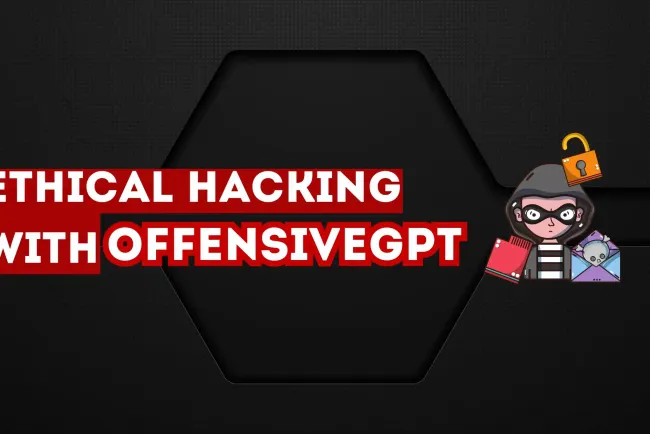How WormGPT is Being Used for Cybercrime ? AI-Powered Phishing Attacks, Malware Development, Social Engineering, Business Email Compromise, and Fraud Prevention
The rise of AI-powered cybercrime tools like WormGPT is transforming the cybersecurity landscape, enabling cybercriminals to conduct more sophisticated attacks at a larger scale. WormGPT, an unrestricted AI model, is being misused to generate phishing emails, develop malware, automate fraud, and conduct social engineering scams with unprecedented efficiency. Unlike ChatGPT and other ethical AI models, WormGPT operates without security restrictions, making it a preferred tool for hackers. Cybercriminals are using it for business email compromise (BEC), financial fraud, and ransomware attacks, significantly increasing the risk for businesses and individuals. This blog explores how WormGPT is used for cybercrime, the threats it poses, and effective cybersecurity measures to defend against AI-driven cyberattacks.

Table of Contents
- Introduction
- What is WormGPT?
- How WormGPT Is Being Used in Cybercrime
- Why WormGPT Is Dangerous?
- How to Protect Against WormGPT Cybercrime?
- Conclusion
- FAQ
Introduction
Cybercriminals are constantly evolving their tactics, and the rise of AI-powered tools like WormGPT is making cyberattacks more sophisticated than ever. WormGPT, an unrestricted AI model, is being misused to automate phishing attacks, malware development, and social engineering at an alarming scale. Unlike ethical AI models that have security filters, WormGPT is designed for offensive cyber operations.
This blog explores how WormGPT is used for cybercrime, its risks to organizations and individuals, and what cybersecurity measures can help defend against AI-driven threats.
What is WormGPT?
WormGPT is an AI-driven language model developed with no ethical constraints, allowing cybercriminals to generate malicious content without restrictions. It is often described as the “ChatGPT for hackers” because it enables users to create phishing emails, malware code, and other cyber threats with ease.
Unlike OpenAI’s ChatGPT, which has built-in security filters to prevent abuse, WormGPT is designed specifically to assist in cybercrime by generating content for fraud, hacking, and digital scams.
How WormGPT Is Being Used in Cybercrime
1. AI-Generated Phishing Attacks
Phishing emails are one of the most common attack vectors, and WormGPT enhances their effectiveness by creating:
- Highly persuasive emails mimicking legitimate sources
- Grammar-perfect scam messages to evade detection
- Context-aware phishing attacks customized for different victims
Since traditional phishing emails often have spelling or grammatical errors, security tools can detect them easily. However, with WormGPT, attackers generate perfectly written phishing emails, making them much harder to spot.
2. Malware and Ransomware Development
Cybercriminals are using WormGPT to:
- Generate malicious code for malware, ransomware, and keyloggers
- Automate script generation for hacking tools
- Enhance existing malware to bypass antivirus detection
Since AI models like WormGPT can generate and optimize code, even criminals with limited technical expertise can create powerful hacking tools effortlessly.
3. Social Engineering Attacks
Social engineering is a psychological manipulation technique used to trick individuals into revealing sensitive information. With WormGPT, attackers can:
- Create realistic fake identities for fraud
- Impersonate executives (CEO fraud) for wire fraud
- Generate fake social media messages for scams
By analyzing human behavior and language patterns, WormGPT helps criminals create highly convincing social engineering attacks that increase success rates.
4. Business Email Compromise (BEC) Scams
Business Email Compromise (BEC) scams involve impersonating corporate executives or vendors to trick employees into transferring funds. WormGPT enables:
- Realistic email impersonation of executives or suppliers
- Context-aware financial fraud by crafting convincing payment requests
- Bypassing security filters with well-written, AI-generated content
By removing grammatical errors and making phishing emails look legitimate, WormGPT helps attackers bypass corporate security filters and deceive employees more easily.
5. Automating Fraud and Fake Reviews
Online fraudsters and scammers leverage WormGPT for:
- Generating fake customer reviews for scams
- Writing fraudulent job postings to steal personal information
- Creating deceptive e-commerce websites that look legitimate
With AI-generated content, cybercriminals can easily mass-produce deceptive materials, making fraud harder to detect.
Why WormGPT Is Dangerous?
1. No Ethical Restrictions
Unlike ChatGPT, Bard, or Claude, which have built-in safeguards against cybercrime, WormGPT operates with no ethical constraints, allowing users to generate malicious content freely.
2. Enables Low-Skill Cybercriminals
WormGPT lowers the barrier for cybercrime, enabling even inexperienced hackers to launch sophisticated cyberattacks. Attackers no longer need coding expertise—AI does the work for them.
3. Increases Attack Volume and Speed
Since AI can generate phishing emails, malware code, and scam content instantly, criminals can launch attacks at a much larger scale compared to manual efforts.
4. Harder to Detect
- Phishing emails generated by AI have perfect grammar, making them harder to identify.
- AI-generated malware code can be customized to evade detection by traditional antivirus software.
This makes AI-powered cyberattacks significantly more dangerous than traditional attacks.
How to Protect Against WormGPT Cybercrime?
1. AI-Powered Email Filtering
Organizations should deploy AI-driven security solutions that detect phishing emails, business email compromise (BEC) scams, and AI-generated fraud attempts in real time.
2. Employee Cyber Awareness Training
Regular training programs can help employees recognize AI-generated phishing emails and social engineering tactics, reducing the risk of human errors.
3. Strong Multi-Factor Authentication (MFA)
MFA adds an extra layer of security against phishing attacks, preventing unauthorized access even if passwords are compromised.
4. Threat Intelligence Monitoring
Cybersecurity teams should monitor dark web forums for WormGPT-related threats and stay updated on new AI-driven attack techniques.
5. Endpoint Security and Malware Protection
AI-powered endpoint detection and response (EDR) solutions can detect AI-generated malware and ransomware before they infiltrate networks.
Conclusion
WormGPT represents a dangerous evolution in cybercrime, making it easier than ever for hackers to launch phishing scams, develop malware, and automate fraud. Unlike ethical AI models, WormGPT has no restrictions, making it a preferred tool for cybercriminals.
To combat AI-driven cyber threats, organizations must adopt advanced cybersecurity strategies, enhance employee awareness, and implement AI-powered security solutions. As AI continues to evolve, both attackers and defenders must adapt to the new reality of cyber warfare.
FAQ
What is WormGPT?
WormGPT is an AI-powered tool designed for cybercriminals, allowing them to generate phishing emails, malware scripts, and fraudulent messages without security restrictions.
How is WormGPT different from ChatGPT?
Unlike ChatGPT, which has security filters to prevent malicious activities, WormGPT has no ethical safeguards, making it a tool for hackers to automate cyberattacks.
Why is WormGPT dangerous?
WormGPT allows low-skilled cybercriminals to execute sophisticated attacks, automating phishing, malware development, and fraud at an alarming speed and scale.
How do hackers use WormGPT for phishing attacks?
Hackers use WormGPT to generate perfectly crafted phishing emails, mimicking real businesses to steal credentials, financial data, and personal information.
Can WormGPT be used to create malware?
Yes, WormGPT can generate malicious scripts, ransomware code, and trojans, enabling criminals to develop advanced malware without needing technical expertise.
What is Business Email Compromise (BEC), and how does WormGPT assist in it?
BEC is a fraud technique where hackers impersonate executives or vendors to trick employees into sending money or sensitive data. WormGPT helps craft convincing, grammatically accurate emails to bypass security detection.
Can AI-generated phishing emails bypass spam filters?
Yes, AI-generated phishing emails are more sophisticated, well-written, and context-aware, making them harder to detect by traditional email security tools.
Is WormGPT available on the dark web?
Yes, WormGPT is sold and distributed on dark web forums, where cybercriminals can access it for illicit purposes.
How does WormGPT help in social engineering attacks?
WormGPT creates convincing fake messages, allowing cybercriminals to manipulate victims into sharing sensitive data, clicking malicious links, or transferring money.
Can WormGPT be used for identity fraud?
Yes, WormGPT can generate fake emails, social media messages, and chatbot interactions, making identity fraud and impersonation attacks more effective.
What role does AI play in modern cyberattacks?
AI automates hacking techniques, improves attack efficiency, and creates customized, deceptive messages, making cyberattacks more scalable and effective.
Can WormGPT be used for ransomware attacks?
Yes, WormGPT can assist in writing ransomware code, encryption algorithms, and extortion messages, making ransomware more accessible to criminals.
How can businesses protect themselves from WormGPT-driven attacks?
Businesses should adopt AI-powered email security, train employees on phishing awareness, implement strong authentication measures, and monitor emerging AI threats.
Can traditional antivirus software detect AI-generated malware?
Many traditional antivirus programs struggle to detect AI-generated malware since it can be uniquely generated, modified, and obfuscated to evade detection.
Are AI-driven cyberattacks the future of hacking?
Yes, AI-driven attacks are rapidly increasing, and cybercriminals are leveraging AI to create more intelligent and adaptive threats.
Can individuals fall victim to WormGPT-driven scams?
Yes, individuals can be targeted through phishing emails, fake job offers, AI-generated fraud schemes, and identity theft scams powered by WormGPT.
How do AI-driven scams compare to traditional scams?
AI-driven scams are more convincing, adaptive, and scalable, making them harder to detect compared to traditional scams with human-generated errors.
Can AI tools like WormGPT help cybercriminals learn hacking?
Yes, WormGPT can generate hacking tutorials, exploit code, and vulnerability analysis, lowering the barrier to cybercrime.
Is there any legal action against WormGPT developers?
As of now, law enforcement agencies are investigating AI-powered cybercrime, but tracking and shutting down WormGPT is challenging due to its dark web distribution.
How can AI-driven fraud affect businesses financially?
AI-driven fraud can lead to massive financial losses, reputational damage, and regulatory penalties for companies targeted by phishing scams and BEC attacks.
Can WormGPT be used for banking fraud?
Yes, cybercriminals can use WormGPT to generate fraudulent bank emails, fake financial statements, and deceptive transaction requests to steal money.
What industries are most at risk from AI-driven cybercrime?
Industries like finance, healthcare, retail, and government are prime targets due to their sensitive data and high financial value.
Can cybersecurity professionals use AI against WormGPT threats?
Yes, cybersecurity experts use AI-driven threat detection tools to identify AI-generated attacks and improve cyber defenses.
Are traditional security measures enough to stop AI-driven cybercrime?
No, traditional security measures alone are not sufficient—organizations must leverage AI-powered security solutions to combat AI-driven threats.
Can AI-generated malware evolve over time?
Yes, AI can adapt malware, refine exploits, and continuously improve attack strategies, making cyber threats more dynamic and unpredictable.
How does WormGPT make deepfake scams more dangerous?
WormGPT can generate fraudulent messages and emails that enhance deepfake scams by impersonating voices, social media accounts, and corporate executives.
Can AI be used for cyber defense against AI-driven attacks?
Yes, AI is being used for cyber defense, threat intelligence, and anomaly detection to counter AI-driven attacks like those powered by WormGPT.
Is AI-driven cybercrime going to increase in the future?
Yes, as AI technology advances, cybercriminals will increasingly exploit AI models like WormGPT for more sophisticated and large-scale attacks.
How can individuals stay safe from WormGPT-driven attacks?
Individuals should stay vigilant, verify suspicious emails, enable two-factor authentication (2FA), and use cybersecurity tools to protect themselves from AI-generated fraud.












![Top 10 Ethical Hackers in the World [2025]](https://www.webasha.com/blog/uploads/images/202408/image_100x75_66c2f983c207b.webp)

![[2025] Top 100+ VAPT Interview Questions and Answers](https://www.webasha.com/blog/uploads/images/image_100x75_6512b1e4b64f7.jpg)









